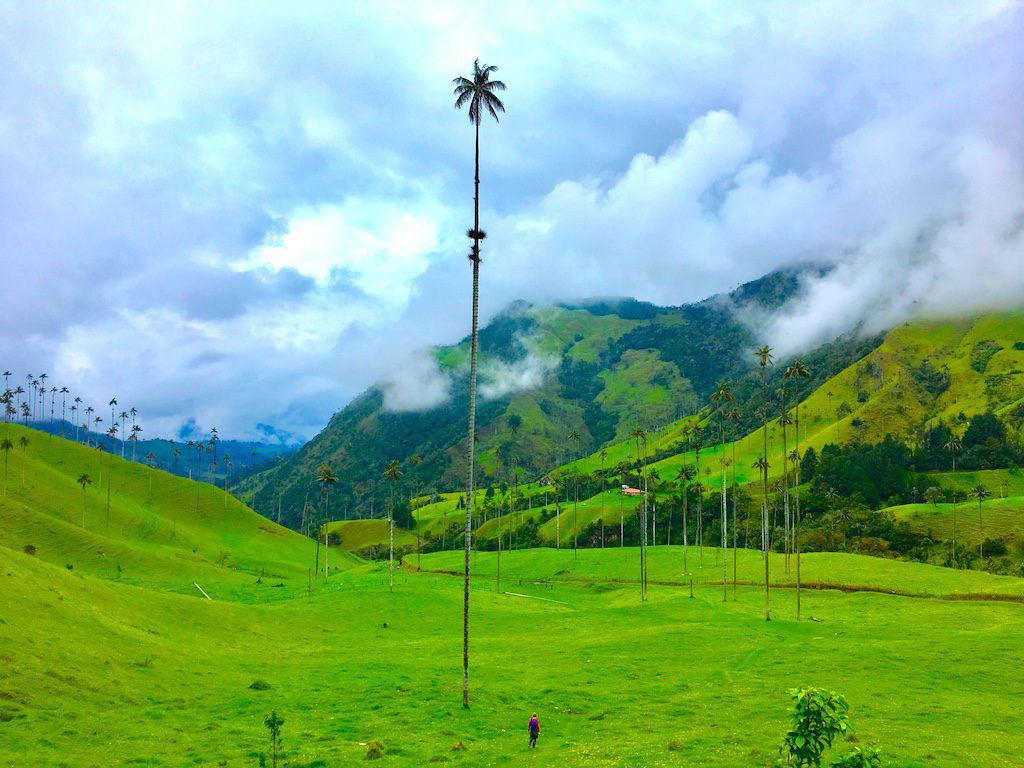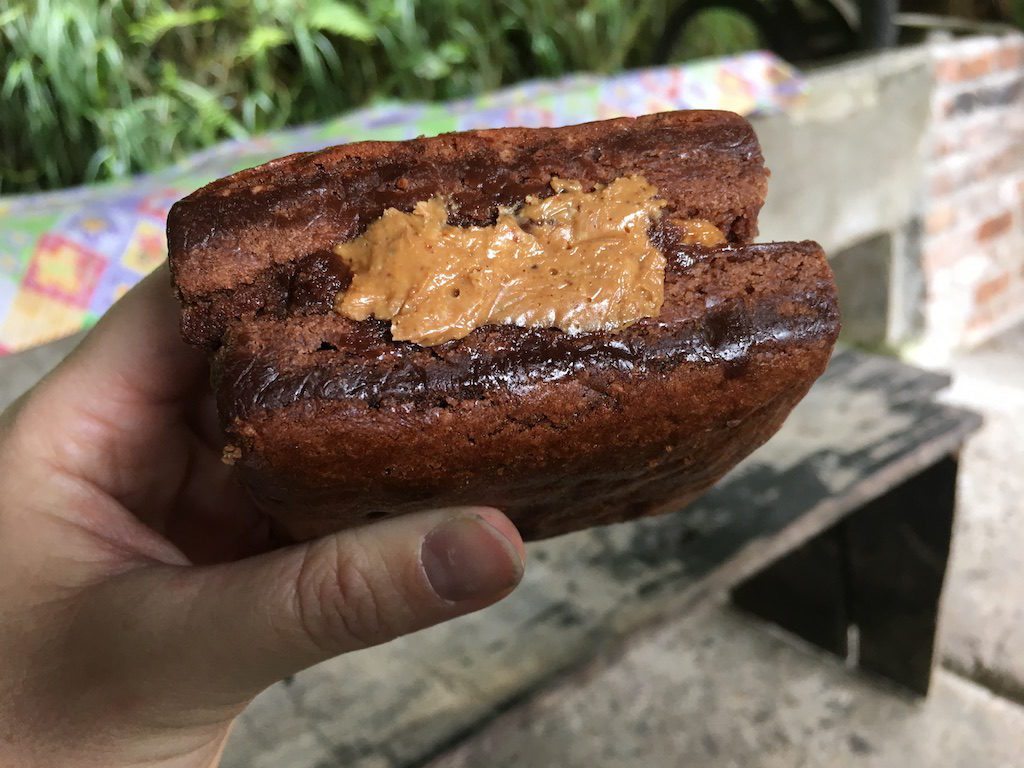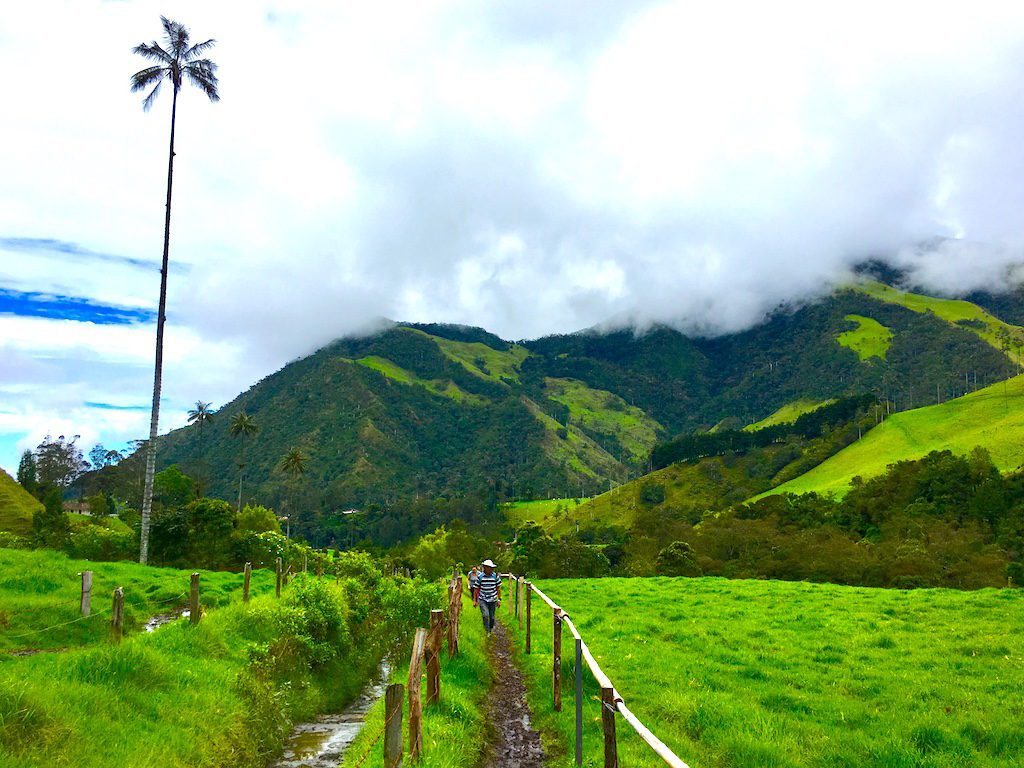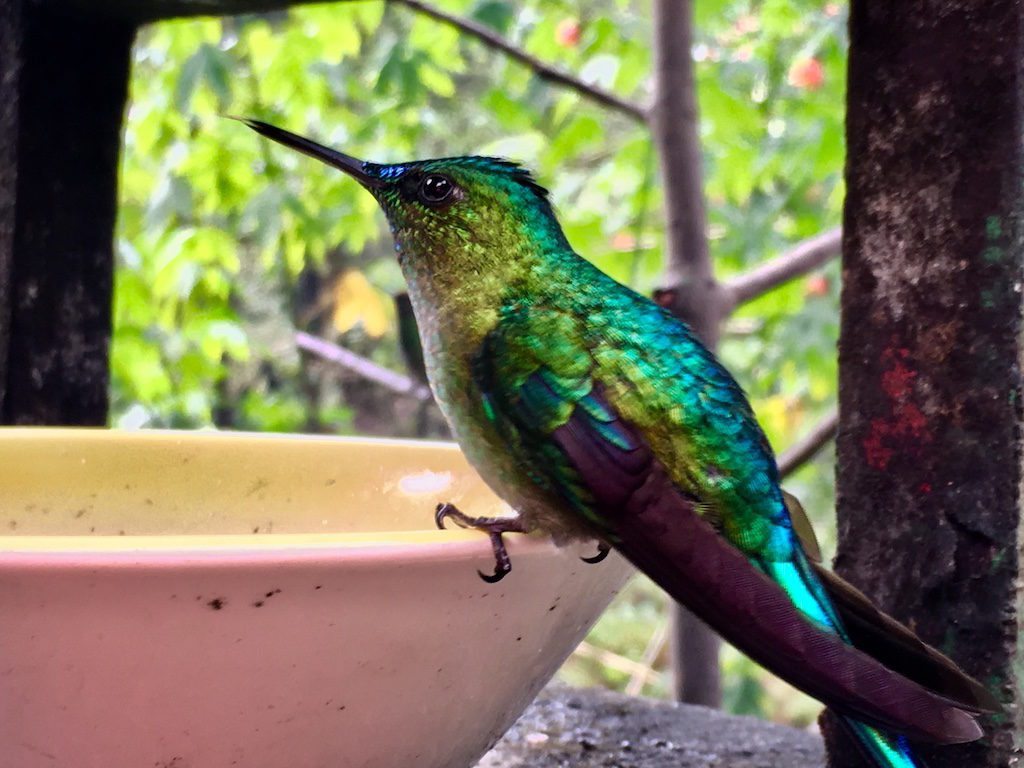If you are headed to the sleepy pueblo of Salento, it is likely because you were drawn to hiking the spectacular Cocora Valley (Valle de Cocora).
This breathtaking area of Colombia is surrounded in emerald green hills and dotted with the country’s national tree – the wax palm. Called the Quindío wax palm, this spindly variety can grow up to 200 feet. Their comical appearance looks like something straight out of Dr Suess’s book The Lorax.

The small dot of a hiker in the foreground of this picture puts in perspective how tall these palm trees are
The valley itself is named after the Quimbayan princess, Cocora, who was the daughter of the local chief Acaime. The name means ‘star of water’. In Spanish that translates to estrella de agua. Two names you’ll see again later.
Whilst you can get to this iconic valley via a short 30-minute walk, I would highly recommend hiking the full loop and enjoying the lush Colombian countryside.
The long route involves a six-hour hike through jungle forest and several river crossings. The reward for the long trek is a hilltop view of the valley at the end.
From this unique advantage point, you get the best perspective of the tall wax palm trees. The trail takes most of the day, but does include ample breaks to enjoy lunch, watch hummingbirds, and snap photos.
Coming to Salento without going to the valley would be like going to Paris and not visiting the Eiffel Tower. You just have to do it. But before you head out, I’d highly recommend thoroughly reading this article as the trail isn’t well marked and there are several obstacles to be aware of.
Prepare Before You Head Out to Cocora Valley
Before you head out on this trek, I’d advise grabbing a few essentials.
First, rent some rubber boots from a hostel in Salento. You’ll definitely need them! The majority of the trek is a quagmire of mud. Additionally, there are several sections where the trail traverses up a stream, where at points is calf deep.
You really don’t want to ruin your own shoes and the rubber boots only cost 5,000 pesos. Also, from my experience and comments from other hikers, the rubber boats had better traction than sneakers. One guy’s whole sole of his shoe came off!

Grab a packed lunch from Brunch in Salento before you head to the Cocora Valle

The peanut butter brownie from Brunch is a must have indulgence whilst in Salento
Second, grab a packed lunch from Brunch. I chose the large packed lunch with the chicken sandwich. For 19,000 pesos, it includes a large bottle of water, a sandwich of your choice, a banana, crackers and homemade peanut butter, packets of homemade granola, and best of all Brunch’s signature Peanut Butter Brownie.
The packed lunch is worth it for the dessert alone. Two large homemade brownies are sandwiched together with homemade peanut butter in a delectable taste sensation.

A map of the Cocora Valley is essential as the trail is not very well marked
Third, print out or download a copy of the map. The trail is not marked and there are several sections that are notoriously hard to follow.

The Cocora Valley is in part of a cloud forest that is often foggy and wet
Finally, it is advised to carry a back-pack with a liter or two of water, sunscreen, and a raincoat. The area is part of a cloud forest, which is typically wet and foggy. Even if it’s sunny in the morning, the weather can quickly change so plan for the worst.
Additionally, the valley sits at between 5,900 – 7900 feet (1,800 – 2,400 meters) and at this altitude the sun is very strong. Even though it was very overcast the day I went, I still got a sunburn.

Willy jeeps take tourists to the start of the Cocora Valley trail from the main square in Salento
How to Get to Cocora Valley
To get to the Cocora Valley from Salento you’ll need to grab a seat in one of the many Willy jeeps that transport tourists and locals at 7 miles (11 km) out of town to the start of the trail. During the weekday, the jeeps depart from the main square.
On the weekend, you’ll need to join one of the jeep convoys leaving from Calle 3, between Carrera 4 and Carrera 3. Anyone in town can point you in the right direction, and might even give you a lift there! Cost is a mere 3,200 pesos each way per person.
The jeep journey is almost as eventful as the hike itself. The driver insists on maximizing his trip so stuffs as many individuals into one load as he can.
Adventurous souls can stand on the back rack and hang on for dear life along the winding road. I chose to be squashed in the inside along with 11 others. Safety over comfort for me.
Luckily, the journey isn’t long. You’ll be deposited in or near a large fenced in area which will be on your left. Some restaurants and toilets will be on your right. Walk straight ahead up and you’ll find a large wooden sign on your right indicating the entrance.
You’ll walk along this path for about 15 minutes, then you’ll meet a check point where you will be asked to pay a small fee to enter the private land and the rest of the hiking trail.
As previously mentioned, the trail isn’t very well marked so take a picture of the map at this check point if you didn’t get one before. And it is advised to listen to the ticket collector’s description of where to head. From here the trail can be divided into three main sections.

The start of the Cocora Valley trail goes through fairly flat, cow-filled pastures
Hiking to the Acaime Hummingbird Sanctuary
The first section of the hike starts out fairly flat through cow-filled pastures, which after about 30 minutes turns into dense jungle forest. The path is extremely muddy and includes many river crossings. Some of which you must wade through, in places calf deep, others involve traversing some rather dilapidated, wooden plank bridges.

The Cocora Valley hike includes several crossings over dilapidated, wooden plank bridges
Eventually you’ll get to a T junction where you will see a red arrow pointing right. This is actually a 40-minute one way detour to the Acaime hummingbird sanctuary. A diversion that I’d highly recommend.
When you get to the end of the trail you will see several homes perched high on the hill. One of these houses the sanctuary and there is a 5,000-peso fee to enter. The fee includes a warming cup of hot chocolate, which you can choose to add a wedge of queso. It’s also a natural stop for a lunch break, as by this point you will be two to three hours into your hike.

The hummingbird’s at the Acaime Sanctuary are accustomed to close interaction with humans
What makes this place really special though are all the hummingbirds flitting around. These iridescent birds are unbothered by the presence of humans here and dart past you by the dozens. This is a rare opportunity to photograph these magical birds in their natural habitat. Not to be missed.

The climb up to the mirador at Finca La Montaña is strenuous
Climbing to the Mirador at Finca La Montaña
After the visit to the hummingbird sanctuary, you will need to backtrack 40 minutes to the T junction with the red arrow sign. Here you should take the left-hand path, the one you haven’t yet been on, to complete the trek.
You might see a sign for a path called Estrella de Agua along the way. Don’t not take this route unless you want to add another three hours to your hike.
The next section is a 30- to 40-minute strenuous uphill climb along a very muddy path. Along the way you may spot some colorful red and white poisonous mushrooms, so don’t forget to look down.
At the top, you’ll reach another resting station called Finca La Montaña. At 9,300 feet, you can take in amazing views on a clear day. On a rainy day, it offers a great refugee to have another cup of hot chocolate and wait out the rain.

The hike downhill from Finca La Montaña offers several scenic viewpoints to stop and take pictures
Traversing Downhill to the Cocora Valley
After leaving the finca, the rest of the journey is downhill along a rocky meandering road. Along the way, the Cocora Valley will start to come into view. In addition, there are numerous scenic viewpoints along the way to snap photos and take in the scenery.
From the valley floor, it’s just a short walk through farmland until you make it back to where you started. Furthermore, there are a couple of cafes and restaurants located here for you to grab a drink or a snack and use the toilet.
Returning to Salento
Willy jeeps will be waiting to take you back to Salento until 6 pm. They usually depart on the hour, but will go at any time there is a full 12-person load.
Top Cocora Valley Hiking Tips
- Start early. Before 9 am if possible. This will offer the clearest views and the least number of tourists.
- Bring lots of small peso notes. There are a few entrance fees and chances to buy some snacks and drinks, but breaking a 50,000 peso note in this area will be challenging.
- If you’ve decided that hiking the Cocora Valley might not be for you, then don’t worry. Horseback rides are available for around 25,000 pesos per hour.
Hiking in Medellín and Colombia
We have looked at three different hikes in Medellín:
- Cerro de Las Tres Cruces in Medellín With Amazing City Views
- Cerro el Volador: A Quick and Beautiful Hike in Medellín
- Cerro Pan de Azucar in Medellín With Incredible City Views
And we plan to look at additional hikes in the Medellín area. We also looked at two other popular hikes in Colombia:
- Guide to Hiking the Spectacular Cocora Valley in Colombia
- Ciudad Perdida: A Guide to Hiking to the Lost City in Colombia
Top Things to See and Do in Colombia
On the Medellin Guru website, we have been looking at some of the most beautiful places in Colombia in a series of top things to see and do in Colombia. This is due to many readers asking about several of these things to do in Colombia.
We have looked at 20 of the top things to see and do in Colombia, in alphabetical order:
- Caño Cristales – the most beautiful river in Colombia, which has also been called the most beautiful river in the world by some people.
- Carnival in Barranquilla – the second largest carnival in the world.
- Cartagena – Oozing history, romance and sun-drenched beaches, the allure of historical Cartagena is hard to resist.
- Ciudad Perdida – the site of an ancient city in Colombia that is older than Machu Picchu in Peru.
- Colombia’s Pacific coast – often overlooked by tourists visiting Colombia but offering untamed nature and undiscovered beauty that is off the beaten path for most foreign tourists.
- Desierto de la Tatacoa – the second largest arid zone in Colombia is Tatacoa Desert, which has surreal desert landscapes and some of the best stargazing in Colombia.
- Guatapé – a picturesque pueblo near Medellín known for its huge rock and lake. And it’s likely the most visited pueblo in Colombia by foreigners.
- La Guajira Peninsula – one of the most visually stunning places in South America, which is located on the northern tip of Colombia where the desert meets the sea.
- Las Lajas Sanctuary – the most beautiful church in Colombia, which has also been called the most beautiful church in the world.
- Medellín’s Christmas lights – Medellín’s annual world-class Christmas lights known as Alumbrados Navideños.
- Medellín’s Feria de Las Flores – Medellín’s world-famous flower festival each year.
- Parque Nacional Natural Los Nevados – a popular national park in Colombia located in the heart of the Colombian coffee region.
- Parque Tayrona – known for its beautiful beaches and the world’s highest coastal mountain range.
- Popayán – a colonial gem in Colombia best known for its white buildings and churches, it’s a city off the beaten path for foreign tourists but is definitely worth visiting.
- Rio Claro Nature Reserve – located about three hours from Medellín, Rio Claro is the perfect place to unplug from hectic daily life and enjoy a picturesque crystal-clear river, canyon and tropical rainforest.
- Salento and the Cocora Valley – Salento is a picturesque pueblo in Colombia’s coffee region and the nearby Cocora Valley is one of the most striking landscapes found in Colombia.
- San Agustín Archaeological Park – the largest group of pre-Columbian monuments and megalithic statues in South America and is a UNESCO World Heritage Site.
- San Andrés – Colombia’s Caribbean island which is a UNESCO World Biosphere Reserve featuring many beaches, islets and coral reefs that are filled with flora and fauna.
- San Gil – Colombia’s adventure capital that is full of things to do including white water rafting, paragliding, caving, rappelling, hiking and much more.
- San Jose del Guaviare – a hidden gem and eco-tourism location off the beaten path and offering wildlife watching, jungle trekking and delving into Colombia’s prehistoric past.
Also, we included Salento and the Cocora Valley in our list of the top 20 tourist attractions in Colombia.
Sign up for the Free Medellin Guru Newsletter – You can see all of the previous Medellin Guru weekly email newsletters and sign up here.

